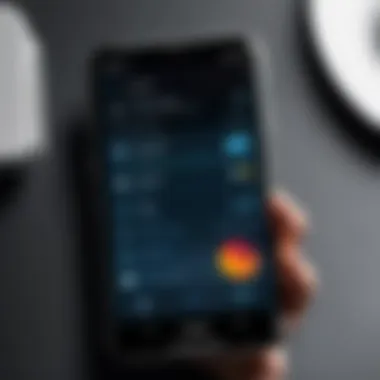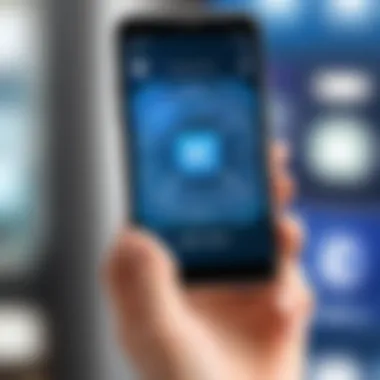Mastering NFC Technology for Mobile Users


Intro
Near Field Communication (NFC) technology has emerged as a transformative force in mobile communication, creating opportunities for seamless interaction and data exchange. Imagine being able to make secure payments, share contacts, or connect to devices with just a simple tap. This guide aims to explore the essentials of NFC, providing you with the insights you need to harness this technology on your smartphone.
As we delve deeper, you will uncover how to enable NFC on a variety of devices, explore practical applications that extend beyond simple payments, and understand the security measures necessary to protect your data. We also acknowledge the occasional hiccups that may arise and offer helpful troubleshooting tips to ensure your experience remains smooth.
"NFC technology isn't just a luxury; it has become a vital functionality in our lifestyle, offering convenience without sacrificing security."
Whether you’re a tech-savvy individual, a gadget enthusiast, or an early adopter, this comprehensive guide is designed to equip you with the knowledge to optimize your mobile experience through NFC technologies.
Understanding NFC Technology
NFC, or Near Field Communication, has grown from a novelty to a pivotal part of mobile technology. With smartphones increasingly becoming the control centers of our lives, understanding how NFC operates is crucial for anyone wishing to optimize their mobile experience. NFC technology enables devices to communicate by simply being close to one another, usually within a range of about ten centimeters. This makes it ideal for quick transactions or data sharing. Furthermore, the simplicity of tapping devices together is a significant benefit. For tech-savvy individuals, grasping the mechanisms of NFC means unlocking a myriad of practical applications that can enhance daily interactions.
What is NFC?
NFC stands for Near Field Communication, a set of communication protocols that enable devices to communicate when they are close together, often at only a few centimeters of distance. By leveraging radio frequency identification (RFID) technology, NFC allows your smartphone or other compatible devices to transfer information seamlessly with a simple tap. For example, when you tap your smartphone to a payment terminal or another NFC-enabled device, data flows between the two without complicated wiring or networks.
It's worth noting that NFC is also compatible with contactless smart cards, making it an easily integrated option for many systems. This seamless integration is part of the charm of NFC technology, allowing for various applications that can make both personal and professional tasks faster and easier.
How NFC Works
To break it down, NFC operates by using electromagnetic fields. When you bring two NFC-enabled devices within range, they create a magnetic field that allows them to transfer data. The communication can either be initiated by one device actively generating a signal or in a passive mode, where the second device emits its signal. Because of these features, NFC works without the need for direct line-of-sight, unlike some other technologies, such as infrared.
This might seem technical, but the user experience is incredibly intuitive. For instance, you can simply hold your smartphone against a coupon or a smart tag and it will beep or vibrate to confirm the transfer of data. It's this ease of use that has contributed to the rising popularity of NFC across myriad platforms.
Common Uses of NFC
The potential applications for NFC technology are widespread, reaching into various sectors. From payment solutions to smart tag applications, the uses of NFC are constantly expanding. Let's break down the most common uses for NFC technology:
Payment Solutions
One of the most significant applications of NFC technology is in payment solutions, where users can make transactions by simply tapping their smartphones at a point-of-sale terminal. This has made mobile payments not only quicker but also more secure. Particularly, digital wallets like Apple Pay, Google Pay, or Samsung Pay utilize NFC to facilitate seamless payment transactions.
The hallmark of this system is its speed; there's no need to fumble for cash or a card. A simple tap, and the purchase is complete. However, it's crucial to recognize that while payment via NFC is widely regarded as convenient, users need to be aware of security measures to safeguard their financial data.
Data Transfer
Another popular aspect of NFC is its ability to transfer data between devices effortlessly. With data transfer, users can exchange contacts, photos, or other files merely by tapping devices together. This feature is especially beneficial in networking scenarios where quick sharing of information can enhance connections.
The ease of transferring files makes NFC appealing in social settings. However, while this method is efficient, users should be cautious of sharing sensitive information, especially if in crowded areas where eavesdropping might be a risk.
Smart Tag Applications


Lastly, smart tag applications represent another innovative use of NFC technology. Smart tags are small, programmable chips embedded in various objects, allowing users to interact with these objects using their smartphones. For example, placing an NFC tag on a promotional poster can redirect the user to a website or social media page instantly when scanned.
Smart tags provide a fun and interactive way to engage with consumers, offering essential data with minimal effort. They are beneficial for businesses looking to bridge offline and online marketing strategies. Nonetheless, businesses and users alike must ensure proper security and privacy measures are in place to protect such interactions from misuse.
Enabling NFC on Your Smartphone
In today's fast-paced digital age, smartphones serve as a central hub for our daily activities. One of the standout features that enhance the versatility of these devices is Near Field Communication (NFC) technology. Exploring how to enable NFC on your smartphone is not just a technical step; it’s a gateway into a realm of convenience that transforms how we interact with the world around us. From making secure payments at your favorite coffee shop to sharing files with a simple tap, knowing how to activate this function can substantially improve your day-to-day life.
Before diving into the details of enabling NFC, it’s crucial to understand why this capability matters. With mobile payments on the rise, your smartphone can turn into your digital wallet. Additionally, NFC opens doors to other useful applications—like connecting to smart devices in your home or exchanging contact information without fumbling for business cards. In short, enabling NFC is more than flipping a switch; it’s about unlocking new capacities for your smartphone that keep pace with our modern lifestyle.
Checking Device Compatibility
Not all smartphones come equipped with NFC technology, so the initial step in enabling it is to verify your device's compatibility. Here’s how to figure it out:
- Look it up: The quickest way is to consult your device's manual or search online for your smartphone model alongside "NFC capability."
- Settings check: Many Android devices have NFC settings located under "Connections" or "Wireless & Networks." For Apple users, iPhones 6 and later come with NFC built in for Apple Pay and other functions.
- Marker on the box: Sometimes the box packaging might have NFC branding, indicating the technology is indeed present.
Knowing whether your device can run with NFC can save a lot of time and frustration.
Steps to Activate NFC on Android Devices
For those with Android smartphones, enabling NFC is a straightforward process. Follow these steps to activate it:
- Open Settings: Navigate to the settings app on your device, usually represented as a gear icon.
- Connections: Scroll down or search for the "Connections" or "Network & Internet" section.
- NFC Setting: You should see an option for "NFC" or "Near Field Communication." Tap on it.
- Toggle: Simply switch the toggle to the right to activate NFC. You might also want to engage "Android Beam" which enables file sharing.
It's worth noting that the precise steps can differ slightly based on the OEM, so if you can’t find it, searching your Settings search bar for "NFC" often does the trick.
Activating NFC on iOS Devices
For iOS users, the process is a tad different. Although iPhones have NFC technology, it operates in a more limited scope than Android. Here’s how to ensure it’s set for use:
- Payment Enabling: Open the Wallet app. Ensure you've set up Apple Pay, as that brings NFC functionality to life during transactions.
- NFC Scanning: While there’s no toggle like Android, NFC automatically operates in the background as long as you have compatible payment options or apps that leverage its functionality.
- App Permissions: If using applications that rely on scans (like smart tags or access cards), make sure the app permissions are active to allow NFC interactions.
While this may seem less direct than Android, the simplicity of Apple’s approach contributes to a seamless experience for the user.
NFC technology has become an integral part of mobile interactions, allowing frictionless communication and transactions in our everyday lives.
Applying NFC in Daily Life
NFC technology continues to rise in prominence, offering a range of applications that enhance how we interact with our devices and the world around us. Integrating NFC into daily life brings convenience and efficiency, creating seamless experiences that previously required multiple steps or cumbersome processes. The significance of this integration lies not only in enhancing the everyday user's interaction with technology, but also in fostering greater efficiencies in various domains, from finance to home automation.
Mobile Payments
Using Digital Wallets
In the context of mobile payments, digital wallets have swooped in to revolutionize how transactions are conducted. These wallets allow users to store their credit, debit, and prepaid card information securely on their smartphones. A key aspect of using digital wallets is that they employ tokenization to protect sensitive payment information. This provides an extra layer of security, ensuring that your data remains confidential and minimizes the risk of fraud.


Key characteristics of using digital wallets include speed and ease of use. Imagine walking into a coffee shop and with just a tap of your phone—your order is paid for. No card fumbling or cash counting needed! This brings an element of convenience that's hard to overlook. Moreover, this type of payment method is increasingly accepted in a vast array of establishments, making it a go-to choice for tech-savvy consumers.
That said, while digital wallets boast numerous benefits, such as reducing the need for physical cards and offering various loyalty programs, users should remain cautious of potential drawbacks, such as relying heavily on their phone battery or the need for a stable internet connection.
Transaction Process
Understanding the transaction process is vital for effectively using mobile payments. When you initiate a payment through your digital wallet, your device communicates with the point-of-sale terminal utilizing NFC technology. This communication happens in mere seconds, offering a frictionless experience that seems almost magical.
A key feature of this transaction process is the instant verification of the payment. Users can receive immediate feedback confirming whether the transaction was successful. This not only speeds up the process but also reduces the anxiety around whether a payment went through or not.
While transactions are quick, it's essential to remain aware of the steps involved, especially when managing multiple payment methods. Keeping everything organized within your digital wallet is crucial to avoid confusion at the checkout.
Sharing Files and Contacts
Sharing files and contacts is another area where NFC showcases its convenience. Users can transfer data between devices by simply bringing them close together. This functionality comes in handy in various scenarios—whether you're sending a photo to a friend or sharing your contact information for a quick meet-up.
The brilliance of this method lies in its simplicity. No need for complex setups or lengthy processes. You just ensure both devices have NFC enabled, align them, and voilà—files are exchanged in seconds.
Smart Home Integration
Finally, let’s touch on smart home integration, which is a fascinating development in NFC technology. People are leveraging NFC to control home devices such as lights, locks, and thermostats straight from their phones. You can set up an NFC tag near the door that, when tapped with your phone, can switch off all the lights, lock the door, and adjust the thermostat on your way out.
This offers a customized experience tailored completely to a user's habits and preferences. It helps streamline multiple operations into one single interaction. Yet, it does call for users to be mindful; setting up these features involves some foresight regarding device compatibility and security settings.
Integrating NFC into everyday activities transcends mere convenience; it stands as a testament to how technology continues to reshape the way we live. By embracing these applications, users find themselves at the forefront of a more seamless, efficient lifestyle.
NFC Security Considerations
In today's fast-paced digital environment, ensuring the safety of our devices and information is paramount. With the growing adoption of Near Field Communication (NFC) technology, the discussion around NFC security becomes more crucial than ever. This section aims to explore potential vulnerabilities associated with NFC and provide best security practices to mitigate these risks.
Potential Vulnerabilities
While NFC technology offers convenience, it does come with its own set of vulnerabilities. One of the significant weaknesses of NFC is its short-range capability, which, while adding a layer of security, does not completely eliminate risks. A savvy hacker could potentially intercept NFC signals within a few centimeters of the transmitting device. Here are some notable vulnerabilities to consider:
- Eavesdropping: This is when an unauthorized party captures the data being transmitted. If a user isn't aware of their surroundings, someone could intercept sensitive information like personal details or payment information.
- Data Corruption: Since NFC transmits data in real-time, there is a possibility for the message to be manipulated mid-transmission, allowing attackers to alter crucial information.
- Relay Attacks: In this scenario, an attacker uses two NFC-enabled devices to relay information between a user’s device and the intended receiver. This can trick users into thinking they are conducting a secure transaction when, in fact, they are not.
It's vital to be aware of these vulnerabilities to take proactive steps towards securing NFC transactions.
Best Security Practices
To securely integrate NFC technology into daily use, individuals should adopt a series of best practices aimed at safeguarding their information. Here are some steps to consider:
- Turn Off NFC When Not In Use: One of the simplest methods to protect against unauthorized access is to disable NFC. If it's not actively being used, there’s no reason for it to remain on.
- Monitor Your Environment: Always be cautious in public spaces. Avoid conducting NFC transactions in crowded areas to minimize the risk of eavesdropping.
- Use Trusted Applications: Ensure that any app handling NFC transactions is from a reputable source. Malicious apps can exploit NFC vulnerabilities.
- Set Up Device Lock: Use strong passwords or biometric locks on devices to prevent unauthorized access.
- Enable Encryption: When using NFC for transactions, it's essential that data is encrypted, adding additional robust layers of security.
- Regular Software Updates: Keep your device's software up to date. Manufacturers often release updates that patch known security vulnerabilities.
By following these practices, users can enjoy the convenience of NFC technology while minimizing associated risks.


Implementing these best practices into daily habits not only enhances security but also fosters confidence in utilizing NFC technology. Awareness and proactive measures are the bedrock of maintaining security when engaging with this innovative technology.
Troubleshooting NFC Issues
Understanding how NFC technology works is one thing, but when you hit a bump in the road, knowing how to troubleshoot can be a lifesaver. Troubleshooting NFC issues is essential because it ensures that users can enjoy the full potential of their devices without unnecessary hiccups.
NFC is designed to make life easier through quick and seamless interactions, be it for payments, file sharing, or smart tag functionalities. However, sometimes things just don’t go according to plan. In this section, we’ll categorize the typical problems users face and then outline the steps to resolve those issues. This will enhance your understanding and competence in managing NFC technology on your smartphone.
Common Problems When Using NFC
When tapping into the power of NFC, several problems might emerge, hindering an otherwise smooth experience. Here are some common issues that users frequently encounter:
- Incompatibility Issues: Not all devices support NFC; knowing your device capabilities is crucial.
- Disabled NFC Settings: Sometimes, the NFC feature might not be turned on, leaving users puzzled.
- Unresponsive Devices: Devices may fail to recognize each other even when placed in close proximity.
- Interference from Other Devices: Other tech like Bluetooth can interfere with NFC connections.
- Software Glitches: Bugs or outdated software can lead to inconsistent NFC performance.
"NFC is not magic; it’s technology that needs care and attention like any other gadget."
Resolution Steps
Resolving NFC issues may seem daunting, but often it's just a matter of systematic troubleshooting. Here’s a step-by-step guide to help you tackle these problems effectively:
- Verify Device Compatibility: Check if both devices have NFC support by visiting the manufacturer’s website or the user manual. If no, it won’t hurt to upgrade your tech.
- Enable NFC Settings: On Android, navigate to Settings > Connected Devices > Connection preferences > NFC and ensure it’s activated. For iOS, go to Settings > General > NFC and make sure it’s on.
- Positioning the Devices: Ensure the NFC antennas on both devices are aligned, usually on the back, and within a few centimeters of each other.
- Reduce Interference: Temporarily disable Bluetooth connections or other wireless settings that might conflict with NFC functionalities.
- Restart Your Device: A simple restart can often clear up minor glitches and restore functions.
- Check for Software Updates: Make sure your device is running the latest software version, as updates can bring performance enhancements and bug fixes.
- Clear Cache and Data: On Android, go to Settings > Apps > NFC Service > Storage and clear cache to resolve lingering issues.
- Factory Reset (as a last resort): If problems persist after all other steps, a factory reset might resolve deep-rooted software conflicts. Of course, back your data up first to prevent loss.
By taking these steps, users can enhance their NFC experience and ensure that technology complements daily life effectively.
Future of NFC Technology
As we move deeper into the digital age, the significance of NFC technology cannot be overstated. It's not just about tapping your phone on a payment terminal anymore; NFC is paving the way for a more interconnected and seamless mobile experience. The future of NFC is ripe with possibilities, and understanding these can help significantly enhance our mobile lifestyles.
One of the most crucial aspects worth noting is its potential to simplify various transactions and interactions. With an increasing reliance on mobile solutions, NFC technology could streamline how we shop, communicate, and manage our daily tasks. Moreover, as businesses embrace this technology, consumers can expect more inventive applications and services that enhance convenience.
In this section, we’ll explore emerging trends and the potential upgrades in smartphone features that promise to shape the future of NFC technology.
Emerging Trends
The landscape of NFC technology is rapidly evolving, and some emerging trends are interesting. Consider the rise of contactless payment solutions like Apple Pay, Google Pay, and various banking apps. These services have gained traction, especially amidst the global shift towards cashless transactions. Not only do they make monetary dealings faster, but they also offer an enhanced level of safety. With biometric authentication like fingerprint or facial recognition, users can securely authorize payments with just a tap.
Beyond payments, NFC's application in public transport systems is gaining momentum. Cities worldwide are adopting contactless cards that utilize NFC technology for seamless fare payments. Travelers can pass through gates with ease, making the experience much more pleasant. It's all about ensuring that technology keeps pace with urban living demands.
Also noteworthy is the potential for NFC to revolutionize smart packaging in retail and food industries. Imagine scanning a product’s packaging with your smartphone to gather information about its origin and freshness. This trend not only caters to the savvy consumer but also helps businesses build trust through transparency.
"Technology shapes our lifestyle, and in turn, our lifestyle shapes technology."
Potential Upgrades in Smartphone Features
As NFC technology continues to evolve, smartphone manufacturers are looking at ways to enhance features linked to NFC functionality. One promising area is improved speed and data transfer capabilities. Future NFC chipsets are likely to offer expedited connection times and broader range capabilities, allowing devices to interact more efficiently with one another.
In addition, increased integration of NFC with other technologies, such as Bluetooth and Wi-Fi Direct, could also revolutionize how we share data. This might lead to hybrid solutions that combine the benefits of these technologies for faster and broader applications, especially in file sharing and smart device interactions. Picture this: transferring large files simply by bringing devices close together, with an interface pristine enough to select files effortlessly.
We're also seeing manufacturers embed NFC in wearables and IoT devices more frequently. This strategic placement opens doors to smart home integrations, allowing users to control everything from door locks to smart lights by merely tapping their smartphones. Imagine coming home, and with a simple swipe or tap on your device, the house adjusts the lights and temperature to your preferences.
The horizon of NFC technology is indeed exciting. With advancements in speed, versatility, and integration across various devices, the future promises a landscape where interactions become not only easier, but also more secure and efficient.



